

 |
|
 | |
I end as a traitor to my party, a traitor who must be shot.
Sergei Mrachkovsky, 22 August, 1936
IN 1936, TERROR REIGNED in the Soviet Union and Anna Akhmatova wrote: "I have seen faces consumed, glimpsed horror under lowered eyelids, cheeks etched by pain." Even André Gide observed after his visit to the Soviet Union in 1936: "In my opinion, no country today not even in Hitler's Germany is the spirit more suppressed, more timid, more servile than in the Soviet Union." Or, as brigade commander S. P. Kolosov whose final fate is unknown expressed it in an anything but timid letter in 1937: "I am afraid to open my mouth. Whatever you say, if you say the wrong thing, you're an enemy of the people. Cowardice has become the norm."
Stalin had won the struggle for power and was now dealing death blows to the opposition by organising uncontrolled terror at every level of society. The purges carried out within the party, the army, among members of the scientific community, artists and prominent cultural figures came to be known as the Great Terror. The term is actually bizarre; terror is hardly a rank great or small but absolute: once it has taken root in a social system it spreads and acquires a life of its own.
The Terror did not stop until Stalin's death, but its foundations were laid by Lenin. A new society was to be created, a new human being was to emerge. But the New Men and Women lived in paralysing fear and the consequences were devastating. For Nikolai Bukharin, himself condemned and shot during the last of the three show trials held in Moscow, the worst aspect of the collectivisation of agriculture was not the privations suffered by the peasants but "the profound psychological change in those communists who took part in the campaign. Instead of going mad, they accepted terror as a normal administrative method and regarded obedience to all orders from above as a supreme virtue."
[1]The number of victims carried off during the Stalin era has not been officially established. Even now, nearly a decade after the dissolution of the Soviet Union, only parts of the archives have been opened to the public, a fact which underlines the continuing sensitivity of the issues involved. When, under Gorbachev, General Dmitri Volkogonov was allowed access to previously classified records, he arrived at the following figures: collectivisation in 1937-38 cost 8.5-9 million lives; in 1937-38, 4.5-5.5 million people were arrested, of which 800,000-900,000 were sentenced to death; at the end of the 1940s, between 5.5 and 6.5 million prisoners were held in the Gulag Archipelago. Volkogonov estimates that the Stalin era claimed between 19 and 22 million lives, not including war victims.
[2]These figures are in substantial agreement with estimates made in the 1960s, without access to the archives, by US researcher Robert Conquest. He calculates that only ten per cent of those sent to the camps in 1936-38 survived.
[3] The majority of those sentenced during the repression of 1936-38 were tried behind closed doors. This was the case, for example, with the purges in the Red Army in 1937, which claimed the following victims: 3 out of 5 field-marshals, 13 out of 15 army commanders, 8 out of 9 admirals, 50 out of 57 army corps commanders, 154 out of 186 divisional commanders, all 16 army corps commissars, 58 out of 64 divisional commissars, all 11 vice-defence commissars and 98 of the 108 members of the supreme military council. In the Communist Party, 98 of the 139 members and candidate members elected to the of the Central Committee in 1934 were executed in 1937-38. [4] And so the purges spread, from the centre to the republics and regions.
![]()
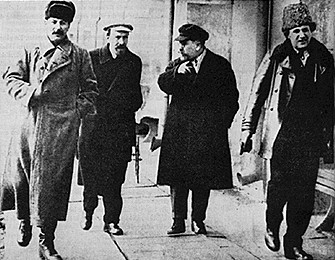
Stalin with three of his Bolshevik comrades, who later became his victims
![]()
It is in this context that the three show trials, held in Moscow between 1936 and 1938 and involving a large part of the old Bolshevik guard, must be seen. It all began in August, 1936, just over sixty years ago, when Kamenev and Zinoviev among others, stood in the dock. The next trial was held on 23-30 January, 1937. Among those charged were Pyatakov, Radek (who received a twenty-year prison sentence) and Sokolnikov. The last trial, with Bukharin, Rykov and Yagoda among the accused was held on 2-13 March, 1983. A total of 54 people were brought before the court during these public trials, 47 of which were sentenced to death. Long prison sentences were handed down to the rest.
![]()
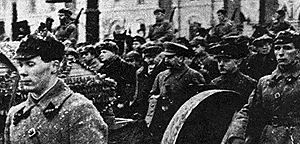
![]()
The murder of the Leningrad Party Secretary, Sergei Kirov in 1934 provided the formal pretext for the terror, the hunt for so-called enemies of the people and the Moscow trials. The latter provided a bizarre theatrical spectacle, in which old Bolshevik veterans confessed to the most conspiratorial crimes against the state they helped to create. The Public Prosecutor Andrei Vyshinsky (a Menshevik up to 1921) drew attention to himself with his notorious demands that "the mad dogs" should be taken out and shot. The accused played their parts, admitting to co-operating with the Japanese and German intelligence services, to conspiracies against both Lenin and Stalin and dealings with Trotsky. Only one person, Nikolai Krestinsky, refused to confess.
![]()
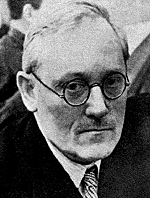
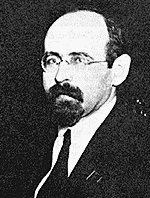
![]()
An old Bolshevik, Krestinsky had been a member of the first Politburo. Under Lenin, he served for a time as secretary of the Central Committee. The exchange in the courtroom on 2 March is worth quoting. At this stage in the proceedings, the President of the Court, V. Ulrich is asking the accused whether they plead guilty to the charges. All reply in the affirmative until:[5]
The President: Accused Krestinsky, do you plead guilty to the charges brought agalnst you?
Krestinsky: I plead not guilty. I am not a Trotskyite. I was never a member of the bloc of Rights and Trotskyites, of whose existence I was not aware. Nor have I commltted any of the crimes with which I personally am charged, in particular I plead not guilty to the charge of having had connections wlth the German intelligence service.
The President: Do you corrobarate the confession you made at the preliminary investigation?
Krestinsky: Yes, at the preliminary investigation I confessed, but I have never been a Trotskyite.
The President: I repeat the question, do you plead guilty?
Krestinsky: Before my arrest I was a member of the Communist Party of the Soviet Union (Bolsheviks) and I remain one now.
The President: Do you plead guilty to the charge of participating in espionage activities and of participating in terrorist activities?
Krestinsky: I have never been a Trotskyite, I have never belonged to the bloc of Rights and Trotskyites and have not committed a single crime.
On the following day, Krestinsky pleaded guilty to the charges:
Krestinsky: Yesterday, under the influence of a momentary keen feeling of false shame, evoked by the atmosphere of the dock and the painful impression created by the public reading of the indictment, which was aggravated by my poor health, I could not bring myself to tell the truth, I could not bring myself to say that I was guilty. And instead of saying, "Yes, I am guilty," I almost mechanically answered, "No, I am not guilty."Vyshinsky preferred to be on the safe side. Krestinsky was executed but rehabilitated in 1965.
Vyshinsky: Mechanically?
Krestinsky: In the face of world public opinion, I had not the strength to admit the truth that I had been conducting a Trotskyite struggle all along. I request the Court to register my statement that I fully and completely admit that I am guilty of all the gravest charges brought against me personally, and that I admit my complete responsibility for the treason and treachery I have committed.
The trials received widespread attention both within and outside the country. What bewildered and frightened people most were the confessions. How could they have confessed? Even Pravda, the Party newspaper, published an article in 1937 under the headline "Why do They Confess?" Reactions to the trials were often marked by naiveté or complaisance or both. The delegation sent by the International Association of Lawyers noted in its report on the first trial; "We consider the claim that the proceedings were summary and unlawful to be totally unfounded.[...] We hereby categorically declare that the accused were sentenced quite lawfully. It was fully proven that there were links between them and the Gestapo. They quite rightly deserved the death penalty."
[6] Bertolt Brecht's remark summed up the views of the intellectual Left: "The more innocent they are, the more they deserve to die." In passing, it may be mentioned that Brecht's former lover, Carola Neher, was arrested in the Soviet Union and vanished without trace.
![]()
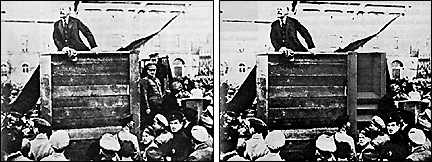
History re-written and retouched. The photo to the left was taken in May, 1920, during a speech by Lenin at the Sverdlov Square. Kamenev and Trotsky are standing on the steps to the platform. The photo to the right was published during the Stalin era.
![]()
There is no doubt that torture was used to force confessions. Though by no means uncommon earlier, torture only became an approved method of examination during the investigations leading up to the first Moscow trial. On 29 July, 1936, an official, albeit secret, document was drawn up, sanctioning the use of "all means" to extract confessions.[7] Krestinsky's submission was clearly the result of a night of brutal torture. Naturally, psychological torture in the form of threats to relatives and the arrest of family members also played their part in the confessions. But, important though it was, torture was not the whole explanation. Many of the accused were hardened revolutionaries. Prosecuted and punished by the Czar's courts, they were themselves advocates of hard methods. Here lies an important part of the explanation: ideological loyalty.
![]()
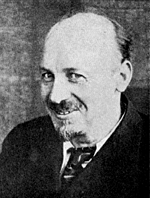
![]()
Bukharin's statement is interesting in that he denied every particular criminal act he was accused of, among them the charge that he conspired to murder Lenin. Nevertheless he pleaded guilty to the charges:
I plead guilty to being one of the outstanding leaders of this 'Bloc of Rights and Trotskyites.' Consequently, I plead guilty to what directly follows from this, the sum total of crimes committed by this counter-revolutionary organization, irrespective of whether or not I knew of, whether or not I took direct part, in any particular act.[8]In his last plea, he explained:
For three months I refused to say anything. Then I began to testify. Why? Because while in prison I made a revaluation of my entire past. For when you ask yourself: ”If you must die, what are you dying for?” - an absolutely black vacuity suddenly rises before you with startling vividness. There was nothing to die for, if one wanted ta die unrepented. And, on the contrary, everything positive that glistens in the Soviet Union acquires new dimensions in a man’s mind. This in the end disarmed me completely and led me to bend my knees before the Party and the country.[9]It has sometimes been said that the terror under Stalin had nothing to do with communism, that the Soviet Union did not rest on true communist foundations. On the contrary, the system had everything to do with communist ideology. The writer Isaac Babel understood this at an early stage. Testimony against him included a statement that in 1938 he had said: "The Soviet Union survives only through its ideology. Without that all would have been over ten years ago. It was ideology that allowed them to carry through the sentences against Kamenev and Zinoviev."[10] Such insights were punishable by death and Babel was shot in 1940.
Babel may have been alone in understanding the significance of ideology in 1938. Today history has vindicated him many years and millions of human deaths too late.
Notes:
1. Nicolaevsky, Boris. Power and the Soviet Elite, New York, 1965, pp. 18-19. [Go Back]
2. Volkogonov, Dmitri. Stalin: Triumph & Tragedy, New York, 1991, pp. 307-08, 524. [Go Back]
3. Conquest, Robert. The Great Terror: A Reassessment, Oxford, 1990, pp. 338-39, 450. [Go Back]
4. Volkogonov. Ibid, p. 310. [Go Back]
5. Report of Court Proceedings in the Case of the Anti-Soviet Block of Rights and Trotskyites, Moscow, 1938, p. 36. [Go Back]
6. Vaksberg, Arkadij. Skjut de galna hundarna! Berättelsen om Stalins åklagare Vysjinskij och hans tid, Stockholm, 1990, p. 124. [Go Back]
7. Conquest. Ibid, pp. 121-22. [Go Back]
8. Report of Court Proceedings in the Case of the Anti-Soviet Block of Rights and Trotskyites, Moscow, 1938, p. 370. [Go Back]
9. Report of Court Proceedings in the Case of the Anti-Soviet Block of Rights and Trotskyites, Moscow, 1938, p. 777. [Go Back]
10. Conquest, Robert. Stalin and the Jews. The New York Review of Books, July 11, 1996, Vol. XLIII, No 12, p. 47. [Go Back]
© Gudrun Persson. About the author.